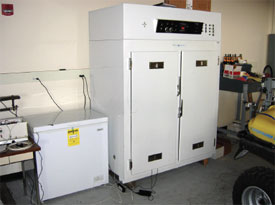Evaluation of Two Fully Rugged Laptop Computers for the Forest Service
Appendix A—Low Temperature Tests
Purpose
These tests were conducted to determine whether the laptop could start and operate properly at extremely cold temperatures that might be encountered during field use. For instance, a law enforcement officer may leave a laptop in a vehicle for an extended period during cold weather and start the laptop after returning, or a researcher might need to use a laptop outside during cold weather.
Equipment
A 7-cubic-ft freezer was used as the cold temperature environmental chamber (figure A–1). Temperatures were monitored using a Campbell Scientific Model CR-1000 datalogger using a Type K thermocouple programmed to record temperatures every second.

Figure A–1—A commercial freezer (left) was used
for the extreme cold
temperature tests. Cold startup
and operation tests were conducted in the
freezer at -15 °F.
Procedure
Tests were conducted under the guidance of MIL-STD-810F (Department of Defense Standard for Environmental Engineering Considerations and Laboratory Tests) Method 502.4—Procedure II (operation). The laptop was cooled to -15 °F and held at that temperature for 2 h. Afterward, the laptop was started and its operation was checked. Once operation tests were complete, the test unit was allowed to warm and a complete visual inspection was conducted.

Figure A–2—Each laptop was placed in the freezer.
The laptops were
left
in the freezer for 2 hours once they
reached a temperature of -15 °F. Then
they were started.
The freezer was run until it reached a temperature of -15 °F. Then the laptop being tested was placed into the freezer with its screen open (figure A–2). The laptop was plugged into line power but was not operating. The freezer was closed and the temperature was monitored until the air temperature inside the freezer reached -15 °F. After 2 h, the freezer was opened and the laptop was started. PassMark BurnInTest 5.3 (software that tests all the major subsystems of a computer simultaneously for reliability and stability) was run to check the functionality of all the laptop's components. The software tests the CPU (central processing unit), hard drives, CD/DVD drives, CD/DVD burners, sound cards, 2-D graphics, 3-D graphics processor, RAM (random access memory), and video playback.
Results
Both laptops passed all tests:
- CF-30: When the CF-30 laptop was turned on after
being cooled, a screen appeared stating that the
unit must warm up for 32 min. Five min later, the
operating system started. The touch screen worked fine, although the screen
was hard to read. It was very
white with little color. The BurnInTest software was
started and allowed to operate for over an hour with
the freezer closed. The temperature remained below
0 °F. All components functioned properly as tested by
the BurnInTest software.
- XR-1: The XR-1 laptop passed all tests, although the test had to be repeated because of a bad CD-ROM disk that produced an error when the CD/DVD drive was tested. After 2 h at -15 °F, the laptop was started. A screen appeared stating that the unit had to warm up for as long as 12 min (figure A–3). Four min later, the operating system started. The touch screen worked fine, although it was hard to read. It was very white with little color. The BurnInTest software was started and allowed to run for about an hour with the freezer closed. The temperature in the freezer remained below 0 °F.

Figure A–3—Neither laptop started immediately. They displayed a screen
like this one (XR-1 laptop) stating it would take time for the laptop to warm
up. Both started within 5 minutes.
The first time the test was run, the DVD drive failed the BurnInTest test. The next day after the unit warmed, the BurnInTest software was run again. Again the DVD drive failed. A different CD was used and the DVD drive passed the test. When the low temperature tests were conducted with the new CD, the XR-1 laptop passed the BurnInTest software test.
Conclusions
Both laptops performed similarly in the low temperature tests. Both started after a brief warm up period (about 5 min) after spending 2 h at -15 °F in the environmental chamber. The screens on both machines were readable although much of the color was not displayed. They passed BurnInTest software tests.
